engine overheat DODGE DART 2013 PF / 1.G User Guide
[x] Cancel search | Manufacturer: DODGE, Model Year: 2013, Model line: DART, Model: DODGE DART 2013 PF / 1.GPages: 604, PDF Size: 4.72 MB
Page 485 of 604
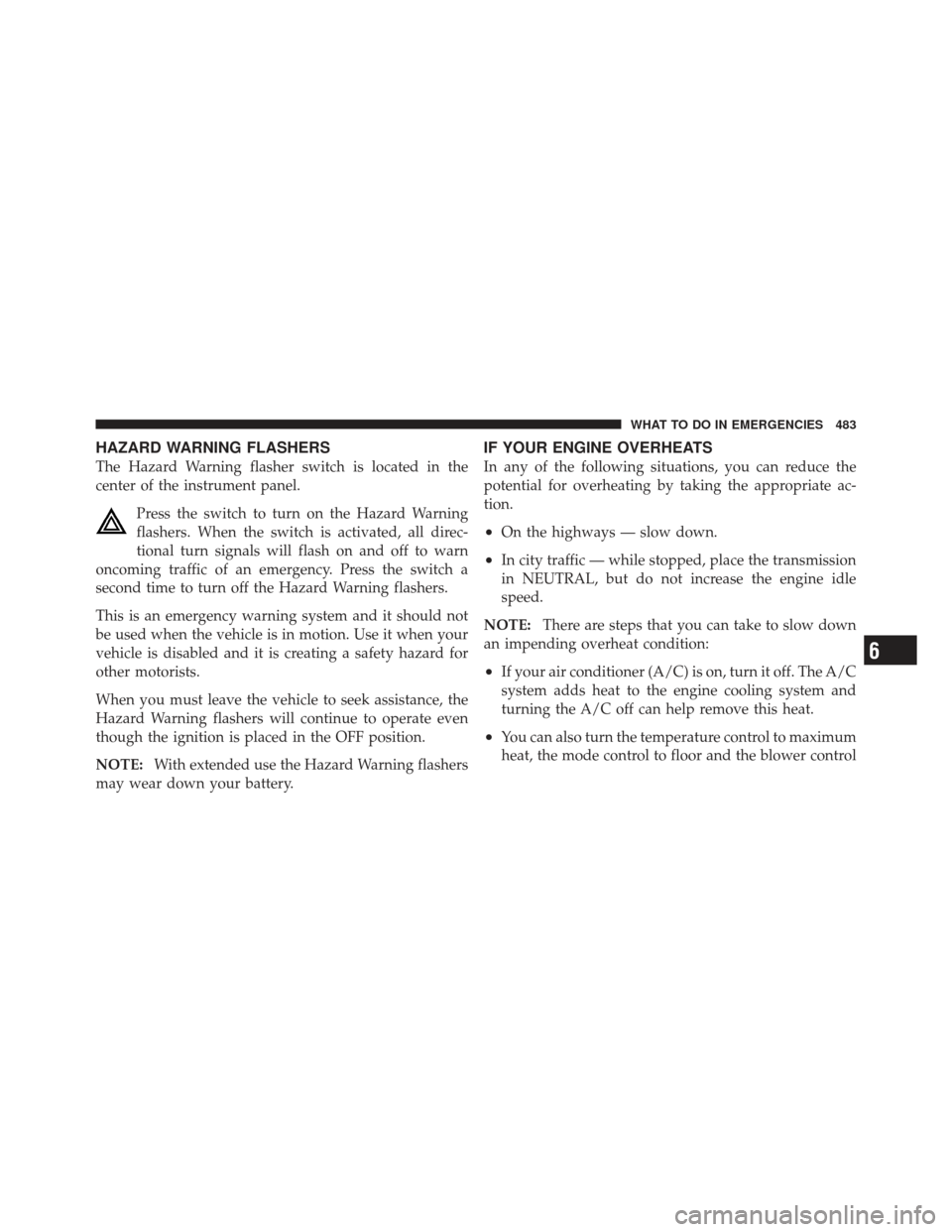
HAZARD WARNING FLASHERS
The Hazard Warning flasher switch is located in the
center of the instrument panel.Press the switch to turn on the Hazard Warning
flashers. When the switch is activated, all direc-
tional turn signals will flash on and off to warn
oncoming traffic of an emergency. Press the switch a
second time to turn off the Hazard Warning flashers.
This is an emergency warning system and it should not
be used when the vehicle is in motion. Use it when your
vehicle is disabled and it is creating a safety hazard for
other motorists.
When you must leave the vehicle to seek assistance, the
Hazard Warning flashers will continue to operate even
though the ignition is placed in the OFF position.
NOTE: With extended use the Hazard Warning flashers
may wear down your battery.
IF YOUR ENGINE OVERHEATS
In any of the following situations, you can reduce the
potential for overheating by taking the appropriate ac-
tion.
•On the highways — slow down.
•In city traffic — while stopped, place the transmission
in NEUTRAL, but do not increase the engine idle
speed.
NOTE: There are steps that you can take to slow down
an impending overheat condition:
•If your air conditioner (A/C) is on, turn it off. The A/C
system adds heat to the engine cooling system and
turning the A/C off can help remove this heat.
•You can also turn the temperature control to maximum
heat, the mode control to floor and the blower control
6
WHAT TO DO IN EMERGENCIES 483
Page 512 of 604
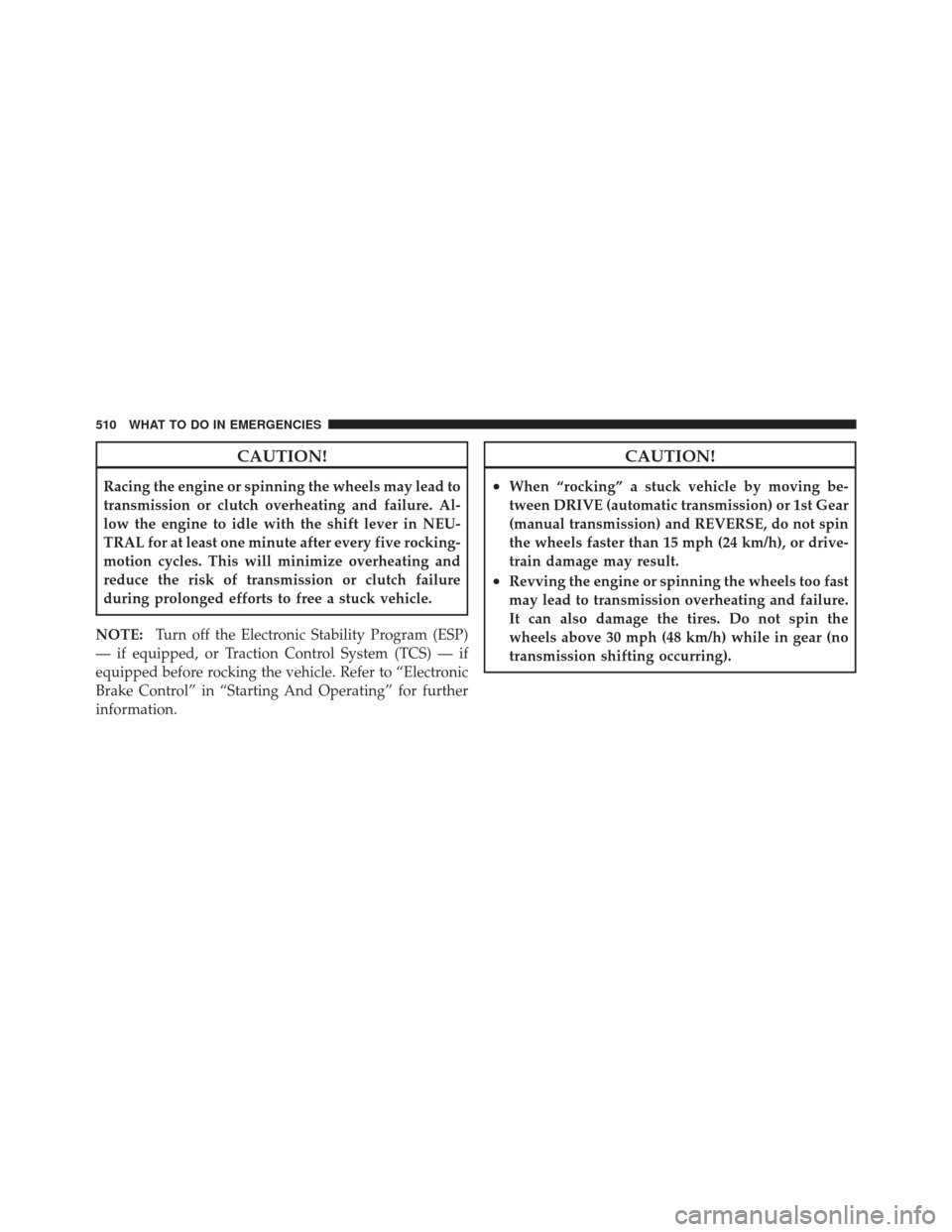
CAUTION!
Racing the engine or spinning the wheels may lead to
transmission or clutch overheating and failure. Al-
low the engine to idle with the shift lever in NEU-
TRAL for at least one minute after every five rocking-
motion cycles. This will minimize overheating and
reduce the risk of transmission or clutch failure
during prolonged efforts to free a stuck vehicle.
NOTE: Turn off the Electronic Stability Program (ESP)
— if equipped, or Traction Control System (TCS) — if
equipped before rocking the vehicle. Refer to “Electronic
Brake Control” in “Starting And Operating” for further
information.
CAUTION!
•When “rocking” a stuck vehicle by moving be-
tween DRIVE (automatic transmission) or 1st Gear
(manual transmission) and REVERSE, do not spin
the wheels faster than 15 mph (24 km/h), or drive-
train damage may result.
•Revving the engine or spinning the wheels too fast
may lead to transmission overheating and failure.
It can also damage the tires. Do not spin the
wheels above 30 mph (48 km/h) while in gear (no
transmission shifting occurring).
510 WHAT TO DO IN EMERGENCIES
Page 537 of 604
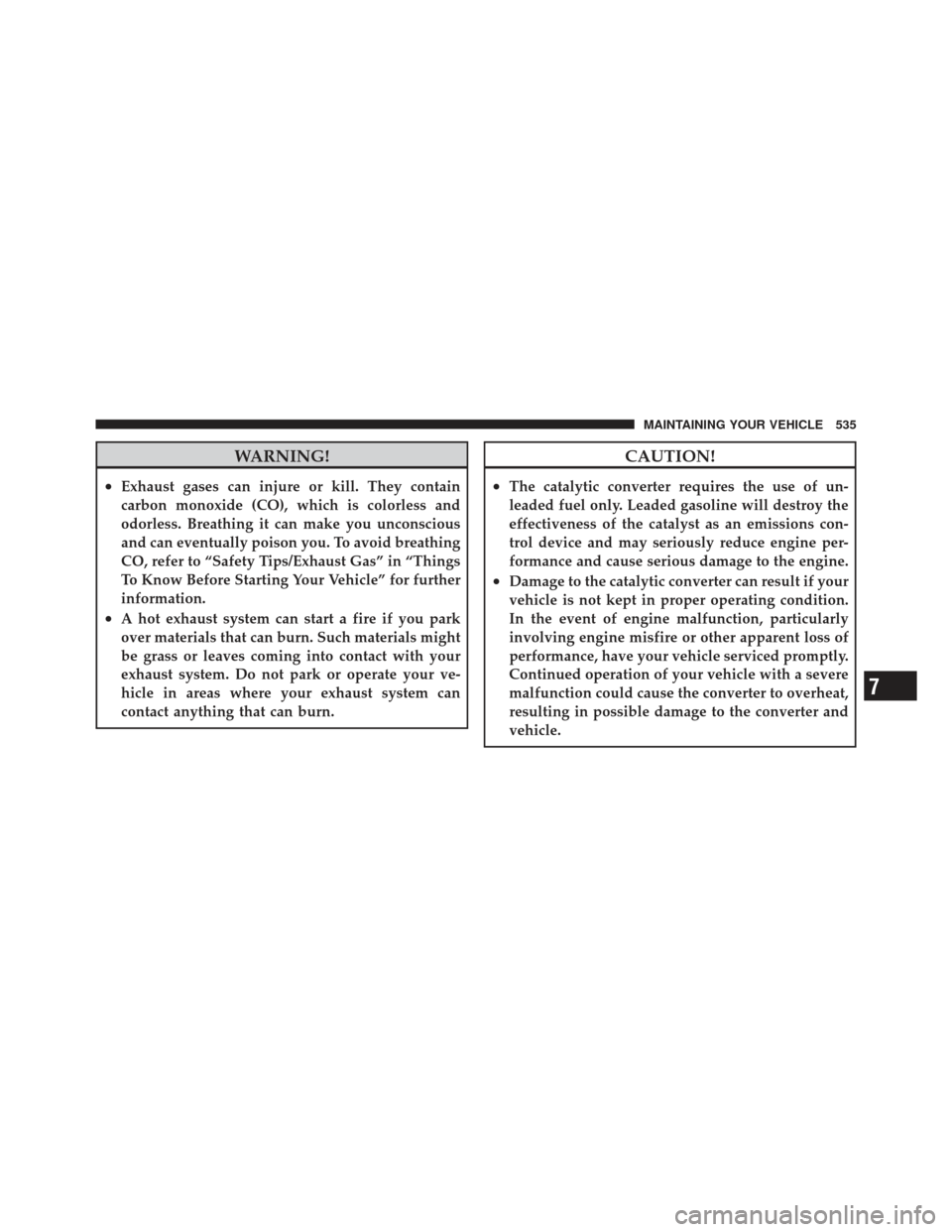
WARNING!
•Exhaust gases can injure or kill. They contain
carbon monoxide (CO), which is colorless and
odorless. Breathing it can make you unconscious
and can eventually poison you. To avoid breathing
CO, refer to “Safety Tips/Exhaust Gas” in “Things
To Know Before Starting Your Vehicle” for further
information.
•A hot exhaust system can start a fire if you park
over materials that can burn. Such materials might
be grass or leaves coming into contact with your
exhaust system. Do not park or operate your ve-
hicle in areas where your exhaust system can
contact anything that can burn.
CAUTION!
•The catalytic converter requires the use of un-
leaded fuel only. Leaded gasoline will destroy the
effectiveness of the catalyst as an emissions con-
trol device and may seriously reduce engine per-
formance and cause serious damage to the engine.
•Damage to the catalytic converter can result if your
vehicle is not kept in proper operating condition.
In the event of engine malfunction, particularly
involving engine misfire or other apparent loss of
performance, have your vehicle serviced promptly.
Continued operation of your vehicle with a severe
malfunction could cause the converter to overheat,
resulting in possible damage to the converter and
vehicle.
7
MAINTAINING YOUR VEHICLE 535
Page 538 of 604
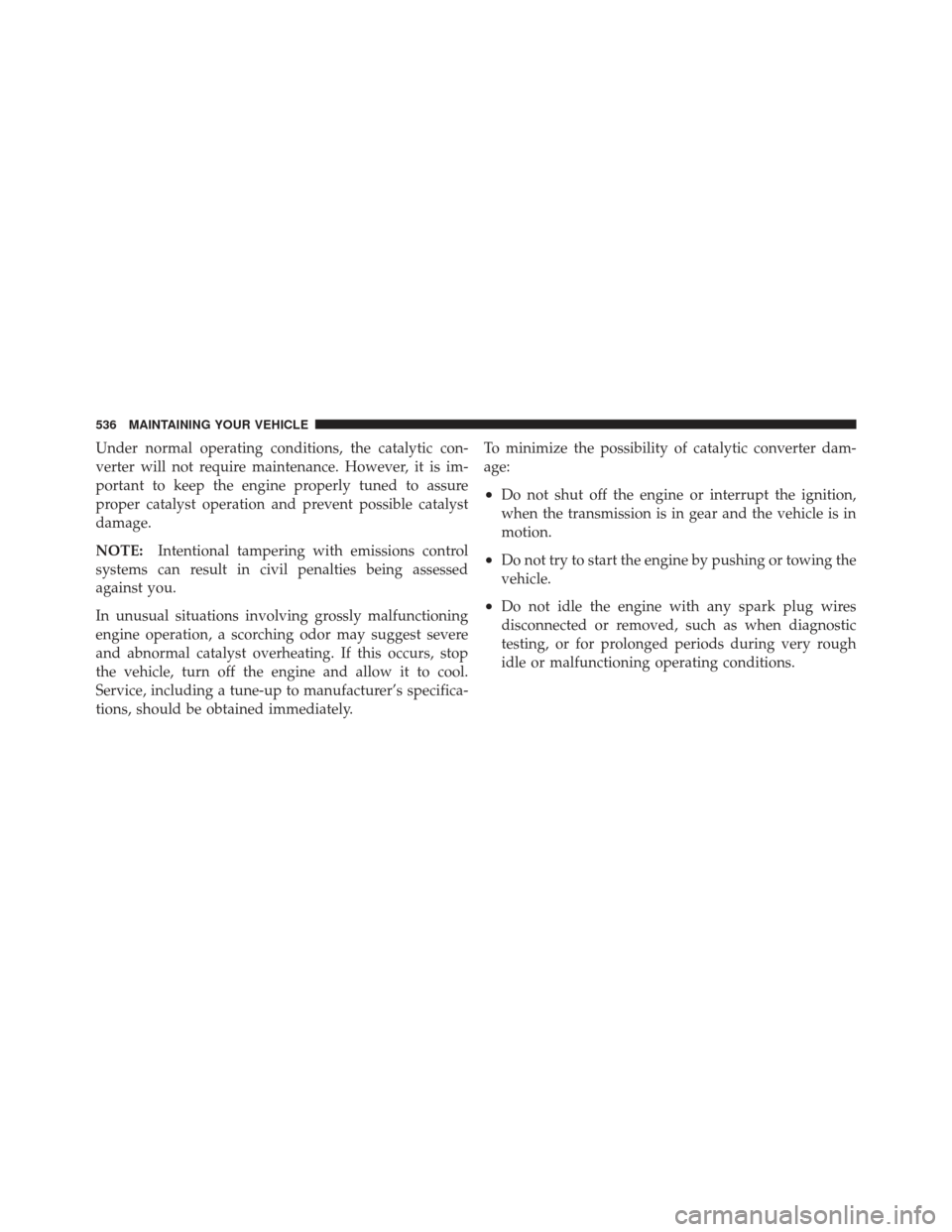
Under normal operating conditions, the catalytic con-
verter will not require maintenance. However, it is im-
portant to keep the engine properly tuned to assure
proper catalyst operation and prevent possible catalyst
damage.
NOTE:Intentional tampering with emissions control
systems can result in civil penalties being assessed
against you.
In unusual situations involving grossly malfunctioning
engine operation, a scorching odor may suggest severe
and abnormal catalyst overheating. If this occurs, stop
the vehicle, turn off the engine and allow it to cool.
Service, including a tune-up to manufacturer’s specifica-
tions, should be obtained immediately. To minimize the possibility of catalytic converter dam-
age:
•Do not shut off the engine or interrupt the ignition,
when the transmission is in gear and the vehicle is in
motion.
•Do not try to start the engine by pushing or towing the
vehicle.
•Do not idle the engine with any spark plug wires
disconnected or removed, such as when diagnostic
testing, or for prolonged periods during very rough
idle or malfunctioning operating conditions.
536 MAINTAINING YOUR VEHICLE
Page 542 of 604
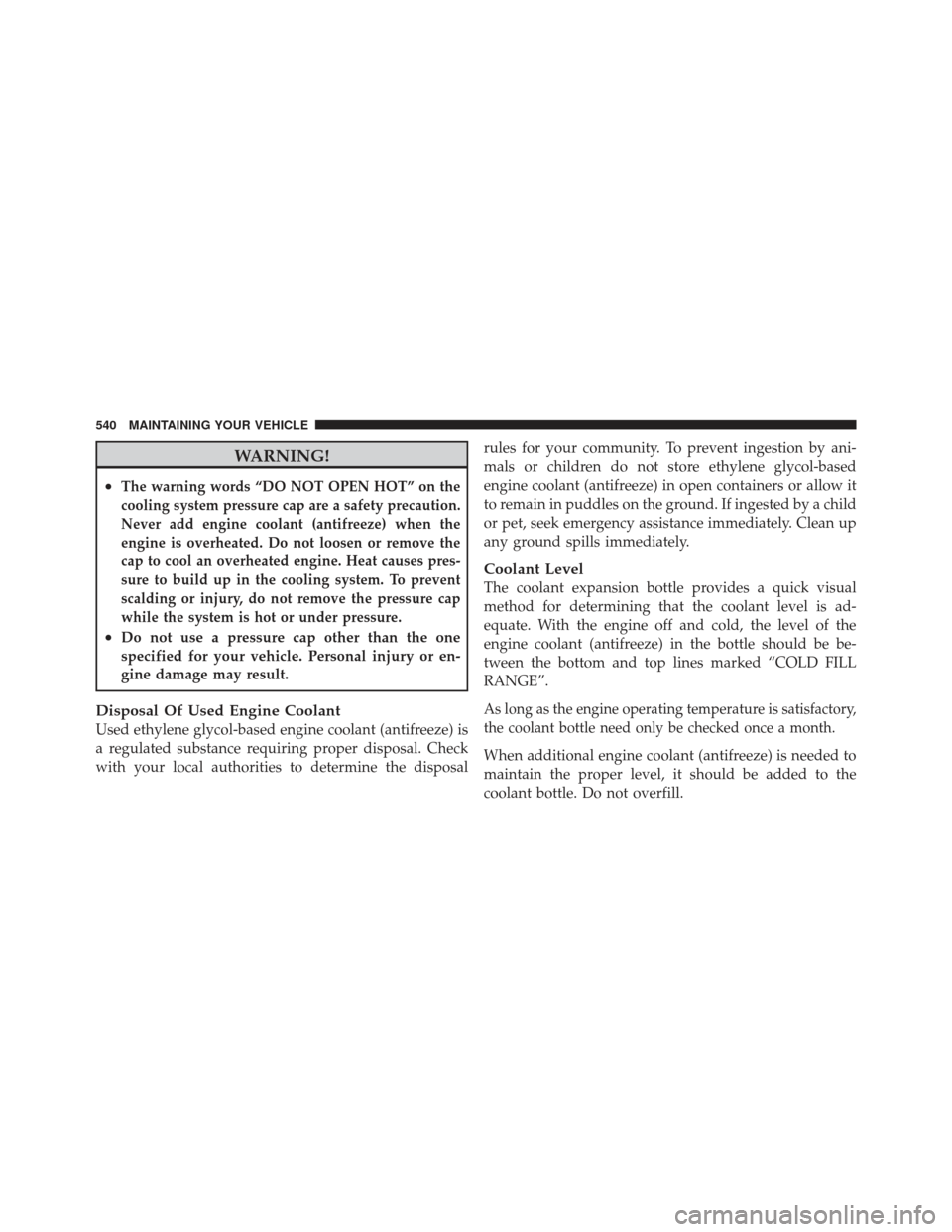
WARNING!
•The warning words “DO NOT OPEN HOT” on the
cooling system pressure cap are a safety precaution.
Never add engine coolant (antifreeze) when the
engine is overheated. Do not loosen or remove the
cap to cool an overheated engine. Heat causes pres-
sure to build up in the cooling system. To prevent
scalding or injury, do not remove the pressure cap
while the system is hot or under pressure.
•Do not use a pressure cap other than the one
specified for your vehicle. Personal injury or en-
gine damage may result.
Disposal Of Used Engine Coolant
Used ethylene glycol-based engine coolant (antifreeze) is
a regulated substance requiring proper disposal. Check
with your local authorities to determine the disposalrules for your community. To prevent ingestion by ani-
mals or children do not store ethylene glycol-based
engine coolant (antifreeze) in open containers or allow it
to remain in puddles on the ground. If ingested by a child
or pet, seek emergency assistance immediately. Clean up
any ground spills immediately.
Coolant Level
The coolant expansion bottle provides a quick visual
method for determining that the coolant level is ad-
equate. With the engine off and cold, the level of the
engine coolant (antifreeze) in the bottle should be be-
tween the bottom and top lines marked “COLD FILL
RANGE”.
As long as the engine operating temperature is satisfactory,
the coolant bottle need only be checked once a month.
When additional engine coolant (antifreeze) is needed to
maintain the proper level, it should be added to the
coolant bottle. Do not overfill.
540 MAINTAINING YOUR VEHICLE
Page 588 of 604
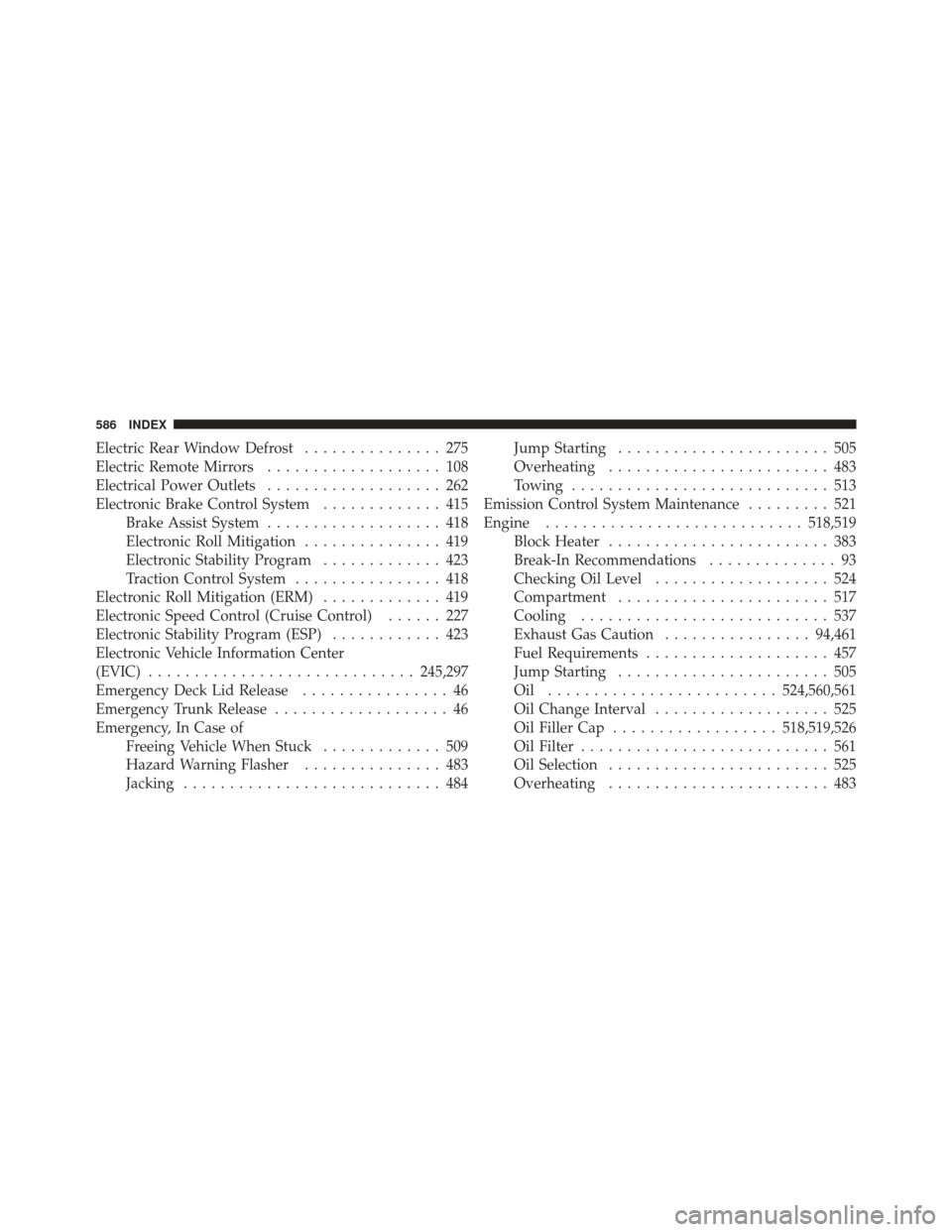
Electric Rear Window Defrost............... 275
Electric Remote Mirrors ................... 108
Electrical Power Outlets ................... 262
Electronic Brake Control System ............. 415
Brake Assist System ................... 418
Electronic Roll Mitigation ............... 419
Electronic Stability Program ............. 423
Traction Control System ................ 418
Electronic Roll Mitigation (ERM) ............. 419
Electronic Speed Control (Cruise Control) ...... 227
Electronic Stability Program (ESP) ............ 423
Electronic Vehicle Information Center
(EVIC) ............................. 245,297
Emergency Deck Lid Release ................ 46
Emergency Trunk Release ................... 46
Emergency, In Case of Freeing Vehicle When Stuck ............. 509
Hazard Warning Flasher ............... 483
Jacking ............................ 484 Jump Starting
....................... 505
Overheating ........................ 483
Towing ............................ 513
Emission Control System Maintenance ......... 521
Engine ............................ 518,519
Block Heater ........................ 383
Break-In Recommendations .............. 93
Checking Oil Level ................... 524
Compartment ....................... 517
Cooling ........................... 537
Exhaust Gas Caution ................94,461
Fuel Requirements .................... 457
Jump Starting ....................... 505
Oil ......................... 524,560,561
Oil Change Interval ................... 525
Oil Filler Cap .................. 518,519,526
Oil Filter ........................... 561
Oil Selection ........................ 525
Overheating ........................ 483
586 INDEX
Page 595 of 604
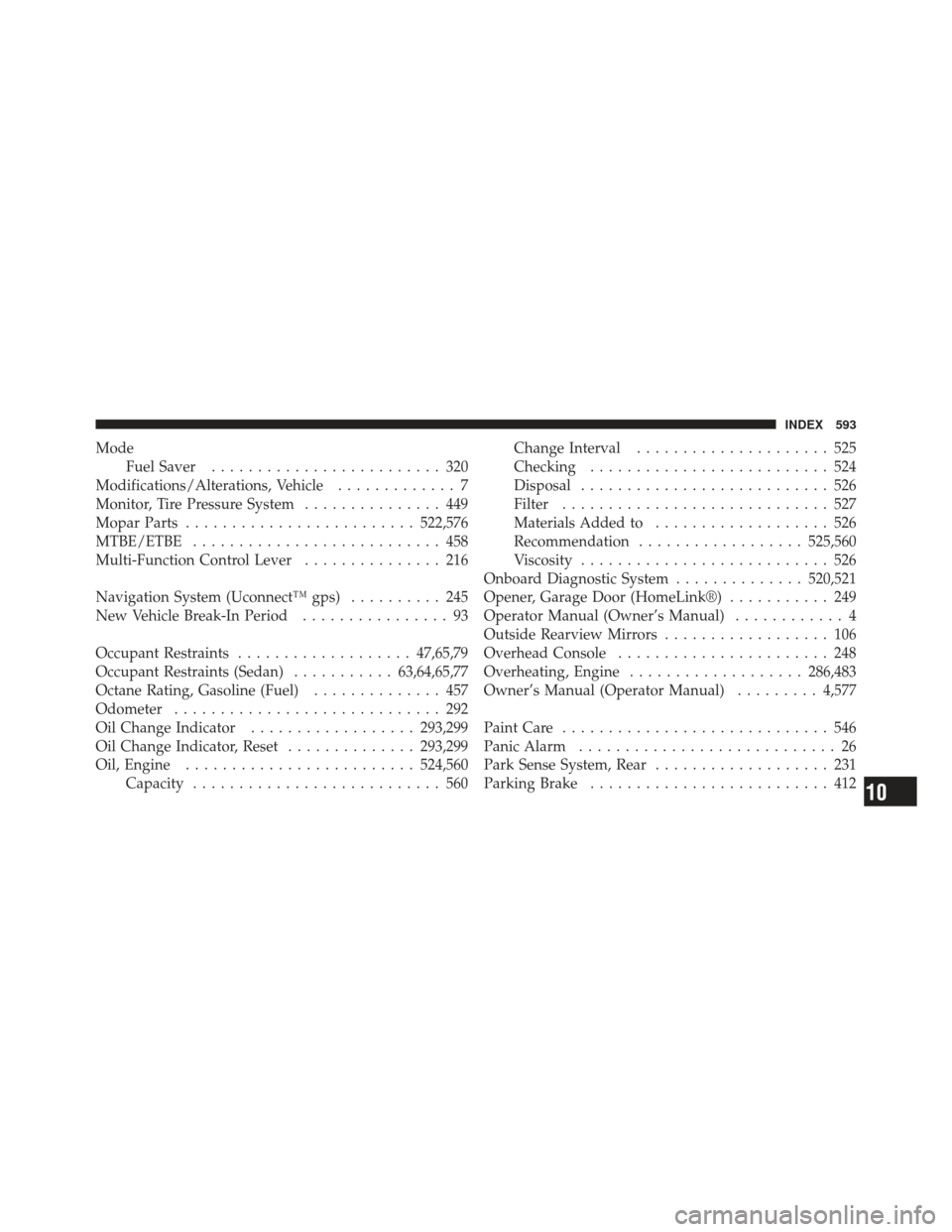
ModeFuel Saver ......................... 320
Modifications/Alterations, Vehicle ............. 7
Monitor, Tire Pressure System ............... 449
Mopar Parts ......................... 522,576
MTBE/ETBE ........................... 458
Multi-Function Control Lever ............... 216
Navigation System (Uconnect™ gps) .......... 245
New Vehicle Break-In Period ................ 93
Occupant Restraints ................... 47,65,79
Occupant Restraints (Sedan) ...........63,64,65,77
Octane Rating, Gasoline (Fuel) .............. 457
Odometer ............................. 292
Oil Change Indicator .................. 293,299
Oil Change Indicator, Reset ..............293,299
Oil, Engine ......................... 524,560
Capacity ........................... 560 Change Interval
..................... 525
Checking .......................... 524
Disposal ........................... 526
Filter ............................. 527
Materials Added to ................... 526
Recommendation .................. 525,560
Viscosity ........................... 526
Onboard Diagnostic System ..............520,521
Opener, Garage Door (HomeLink®) ........... 249
Operator Manual (Owner’s Manual) ............ 4
Outside Rearview Mirrors .................. 106
Overhead Console ....................... 248
Overheating, Engine ................... 286,483
Owner’s Manual (Operator Manual) .........4,577
Paint Care ............................. 546
Panic Alarm ............................ 26
Park Sense System, Rear ................... 231
Parking Brake .......................... 412
10
INDEX 593